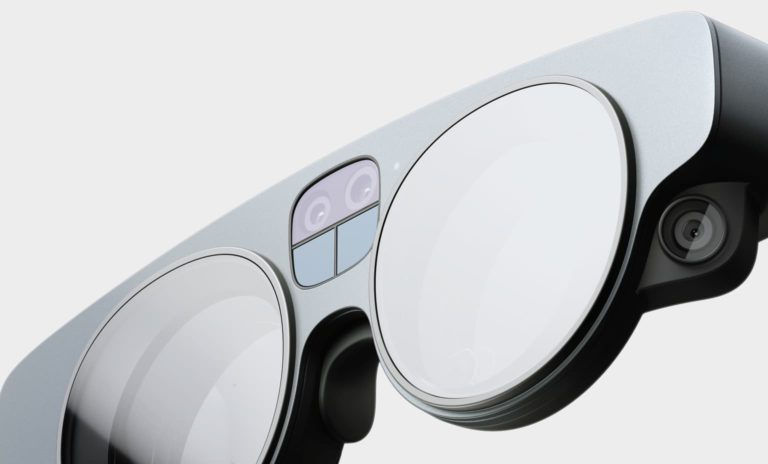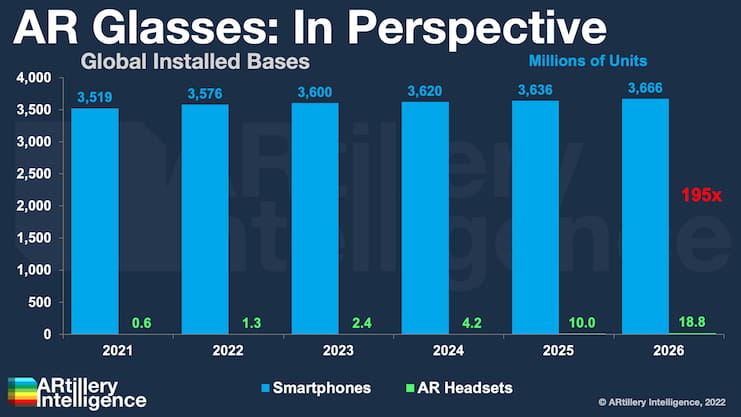
Like many analyst firms, market sizing is one of the ongoing practices of AR Insider’s research arm, ARtillery Intelligence. A few times per year, it goes into isolation and buries itself deep in financial modeling. One such exercise recently zeroed in on headworn AR revenues.
This takes the insights and observations accumulated throughout the year and synthesizes them into hard numbers for spatial computing (see methodology and inclusions/exclusions). It’s all about an extensive forecast model coupled with rigor in assembling reliable inputs.
So what did the latest headworn AR forecast uncover? At a high level, revenue is projected to grow from $1.85 billion in 2021 to $35.1 billion in 2026, an 80.7 percent CAGR. This is steep growth that leans on a few potential wild cards and inflections, such as Apple’s market entrance.
Drilling down, our latest Behind the Numbers installment zeroes in hardware unit sales. How many AR glasses are shipping today? And how is that projected to grow over the next few years? These are key questions as hardware is the starting point for an ecosystem in any emerging tech.
Semblance of Ubiquity
Starting at the top, AR headsets are projected to grow in unit sales from 390,000 in 2021 to 10.13 million in 2026. That correlates to an installed base of 18.8 million units in market by 2026. These totals include enterprise and consumer hardware, the former leading in early years.
Specifically, enterprise accounts for 308,000 units in 2021, growing to 2.85 million in 2025. Consumer AR glasses will trail enterprise in early years but then pull ahead in later years with 7.28 million units projected in 2026. This makes consumer markets the long-run AR revenue leader.
Why is this? Consumer markets are generally larger than enterprise markets, though they can often trail in early stages. That pattern is pronounced in AR where the hardware isn’t yet stylistically viable for consumer markets, causing them to lag relative to style-agnostic enterprises.
Those consumer AR market barriers will alleviate over time through improving AR glasses specs and standards (size, weight, style, etc.). Another accelerant that accounts for steep revenue growth is the ultimate wild card in the AR glasses world noted above: Apple (more on that in a bit).
But putting all of the above into perspective, the 18.8 million installed base in 2026 is dwarfed by the global smartphone installed base by almost 200 to 1. So though AR glasses could grow fast and from a small base, they have quite a ways to go to reach any semblance of ubiquity.

Purpose-Built
Back to Apple, speculation on its market entrance (timing and substance) could fill its own article. For now, we’ll say that it will likely dominate consumer AR market share due to a current void, and its track record in mainstreaming emerging tech through its signature halo effect.
But it’s not just about Apple. There will be success stories for specific use cases such as social (Snap Spectacles) and gaming (Tilt Five). We could then see other purpose-built hardware develop over time in different verticals and use cases as the AR market matures.
That verticalization could be most pronounced in enterprise markets, where growth will be driven by strong ROI for AR-guided productivity in areas like assembly, maintenance, and field service. Speaking of enterprise markets, we’ve seen things shift quite a bit in the past year.
For one, market-leading Microsoft (HoloLens 2) has experienced headwinds, including turbulence in its massive U.S. Army contract, and some key personnel scandals/departures. Meanwhile, the previously-beleaguered Magic Leap has quite a turnaround underway.
Magic Leap’s second act is perhaps the most notable phenomenon in the AR glasses landscape. In short, it involves a leadership shakeup, and a “follow the money” near-term pivot to enterprise markets. At the center of it all is AR’s comeback kid, Magic Leap 2 (see our review).
We’ll pause there and continue tracking the sector’s performance as it twists around and takes shape in its transition to adolescence. Meanwhile, see the full report here.






